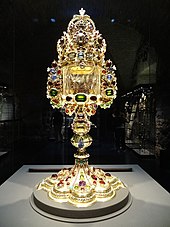Cologne Cathedral Treasury
The Cologne Cathedral Treasury of the Metropolitan Chapter of the High Cathedral Church belongs to Cologne Cathedral . It is located on the north side of the cathedral and in it large parts of the Cologne cathedral treasure are exhibited. Christian art from the 4th to the 20th century is shown there. The cathedral treasury was inaugurated on October 21, 2000 and was heavily criticized at the time. For many felt the cube, which is encased in dark bronze panels and which represents the entrance area to the cathedral treasury, as a foreign body in front of the Gothic north facade of the cathedral.
The cathedral treasury is located underground in medieval vaulted rooms. It has six rooms on three floors. It leads down to the Roman city wall and a Roman sewer. It shows utensils from the Catholic liturgy as well as reliquary containers and crosses. Some of these objects are occasionally also used in the liturgy, such as the pomp of monstrance that is carried in the Corpus Christi procession , a large emerald cross that is used on All Saints' Day , and the baroque shrine of St. Engelbert , which is displayed on his memorial day, the November 7 , is brought out. The cathedral treasury has been headed by the art historian Leonie Becks since 2014 .
Special exhibits
The St. Peter's rod is one of the special exhibits . It is a simple wooden stick with an ivory knob from the 4th century and a metal collar from the 8th century. A choir cloak from 1742, which is kept in the parament room, is also unique . It is part of an ensemble of robes which Elector Clemens August von Bayern commissioned in France to wear to the coronation of his brother Karl Albrecht . The ensemble is called Capella Clementina and it includes, in addition to the choir cloak, two deacon robes and five mitres made of gold embroidery. The robes were last shown in 2000 in Augustusburg Castle in Brühl . Other items are shown on the bottom floor. They come from two graves from the Merovingian period, which were discovered under the cathedral and excavated in 1959.
An example of German handicrafts is the Apokalyptische Lamm , a work by the Cologne goldsmith Johann Heinrich Rohr .
Special exhibitions
- 2010: Hidden Treasures. Masterpieces of Gothic goldsmithing from Cologne (December 3, 2010 to April 3, 2011, for the tenth anniversary of the new presentation)
- 2013/14: Fantastic visual worlds in gold and enamel. For the restoration of a Romanesque reliquary (November 1, 2013 to March 31, 2014)
- 2014/15: CASPAR MELCHIOR BALTHASAR. 850 years of adoration of the Magi in Cologne Cathedral (July 19, 2014 to January 25, 2015) (and in the Hubertus Chapel)
- 2015/2016: The Cologne Cathedral and the Prussians .
- 2017: Ewald Mataré and the Cologne Cathedral .
- 2017/18: Manuscripts from the Cologne Cathedral Library with texts and miniatures for the Christmas festival
- 2019: Close to it, the Christ window in Cologne Cathedral
Cathedral treasure theft
Epiphany shrine
As early as 1820, the Shrine of the Three Kings was damaged and robbed, with precious stones and parts of the golden cladding being stolen. As a result, the Shrine of the Three Kings was restored until 1822.
Cathedral treasury from 1975
Three intruders of foreign origin broke into the cathedral on the night of November 2, 1975. Using rope ladders and mountaineering equipment, they entered the old cathedral treasury in the north transept through a ventilation shaft. The cathedral treasury was considered to be optimally secured at the time. The burglars stole valuable monstrances and crosses. The damage might have been even greater if the intruders hadn't accidentally dropped a monstrance and had to flee. Several times they were close to being caught.
However, the burglars were able to flee after the crime and had melted down part of their booty, like the golden monstrance from 1657. It was restored by Peter Bolg in 1988, with some preserved parts of the old monstrance being reused. The greatest loss is the irretrievably lost pax tablet from Cardinal Albrecht von Brandenburg from around 1533. A pectoral cross from the end of the 17th century is only preserved in fragments. A jeweled bouquet of flowers in goldsmith work from around 1657 is also only preserved in individual fragments. In addition, several episcopal rings have been lost. Finally, with the help of the Cologne underworld and the private detective Werner Mauss , the intruders were caught and sentenced to long imprisonment.
Lecture cross theft 1996
In 1996, unknown thieves stole the valuable lecture cross from the cathedral treasury , which is traditionally carried forward when the Cologne metropolites (archbishops) enter the cathedral . The Cross was at the request of the then Provost Bernard Henrichs of Henry Shepherd through his contacts in the demimonde be retrieved.
See also
literature
- Leonie Becks : The treasure chamber of Cologne Cathedral: short guide. Verlag Kölner Dom, Cologne 2003, ISBN 978-3922442479 (not viewed).
- Barbara Schock-Werner (eds.), Rolf Lauer , Leonie Becks: The treasure chamber of Cologne Cathedral. Verlag Kölner Dom, Cologne 2000, ISBN 978-3922442417 (not viewed).
Individual evidence
- ↑ Article Krummstab hoch in DER SPIEGEL, 1975 edition.
- ^ Marie Therese Mörsch: The Cathedral Treasury 1975. Twenty years later. In: Kölner Domblatt 1995. 60th episode. Verlag Kölner Dom, Cologne 1995. ISBN 3-922 442-24-2 , pp. 245-289.
- ↑ Peter Bolg, Paula Zieleskiewicz: The cathedral treasure robbery 1975. restoration and recovery report. In: Kölner Domblatt 1995. 60th episode. Verlag Kölner Dom, Cologne 1995. ISBN 3-922 442-24-2 , pp. 269-290.
Web links
Coordinates: 50 ° 56 '30.2 " N , 6 ° 57' 30.7" E


